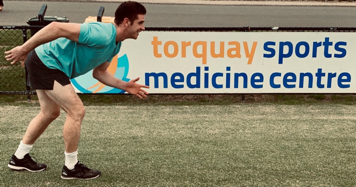My personal experience with a Calf tear…
The first day of preseason training is a day most football players dread. Every year it sneaks up on you so fast you’re left scratching your head wondering; where did the off-season go!? The elation of being reunited with your teammates dissipates quickly at the start line of the 2km time trial which marks the beginning of a gruelling, hot summer training block leading into Christmas.
I hadn’t even completed the first lap of the time trial when I felt a sudden sharp, stabbing pain in my left calf… “Snap” I felt like I’d been shot! As I hobbled off the track to find an ice pack there were many thoughts running through my head:
“Oh no I’ve done my calf!”
“Aren’t calf strains an old man injury?!”
“I’m only 26!”
“How am I going to get back from this!?
Even as an Osteopath who sees and treats acute conditions, I was still quite shocked as I’d never had a soft tissue injury before. I decided to do what every scientist does in a time of need; Research! Here are the important things to know about the dreaded calf strain along with a five step plan to get you back to doing what you love.
What happens when I strain my calf?
The word ‘calf’ is a general term that refers to the group of muscles, tendons and connective tissue on the back of our lower leg. Any of these structures can be injured during a “calf strain” however the medial head of the gastrocnemius muscle is most commonly affected. Typically, people injure their calf during running and jumping activities (football, tennis, basketball etc.) and these tears often occur when the individual hasn’t warmed up appropriately. Medical practitioners assess the severity and recovery time of calf strains using the following system:
| Grade 1: | Mild over-stretching of calf muscle fibres: what we call “micro-tears”. |
| Recovery time: | Approximately 1-2 weeks with appropriate injury management. |
| Grade 2: | Partial tearing of calf muscle fibres. “Not-so-micro” tears. |
| Recovery time: | Approximately 1-2 months to return to sport. |
| Grade 3: | Complete rupture of calf muscle fibres. Not ideal. You may even be able to feel a tiny gap in your injured calf muscle. |
| Recovery time: | Full recovery can take several months. A surgical opinion may be needed. |
What should I do after I’ve strained my calf?
The length of your recovery will of course depend on the severity of your injury (luckily or unluckily for me I only suffered a grade 2 tear). It is helpful, however, to break down your recovery into the following five stages:
- Manage your acute symptoms:
Start the RICE procedure as soon as possible to manage your pain and inflammation:
Rest (get off your feet), Ice (place an ice pack or frozen peas on your calf: 15mins every hour), Compression (place a compression sock or bandage on the injured leg), Elevate (try and rest your injured leg above heart level to assist in the removal of swelling). Try to carry out RICE for at least the first 48 hours post-injury and until pain subsides.
- Regain full range of motion:
You may not be able to walk properly yet but it’s vital you get some movement back into your calf and ankle as soon as you can. Making big circles with your big toe is a great way to start. As your calf heals and allows you to weight-bear you can start building into a standing calf stretch against the wall and eventually on the edge of a step. Compare your range of motion to your uninjured side using the knee-to-wall test (shown below). Foam rolling and self-massage with anti-inflammatory gels are also terrific for releasing any muscle tightness that may have. come on since injury.
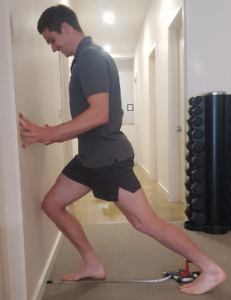
- Get your calf stronger than it was before:
This can be a very slow process and will take some dedication and patience. Build up slowly from band-resisted toe points seated calf raises with weight standing two leg calf raises (bodyweight) standing single leg calf raises (body weight) single leg calf raises holding a weight. I would highly recommend seeing your Physiotherapist, Podiatrist, Osteopath or Exercise Physiologist to get a structured strengthening program specific to your injury and stage of healing. Often people fall into the trap of dropping their program when they reach pre-injury calf strength and this more often than not results in repeat strains. Let’s aim to get it stronger than ever before!
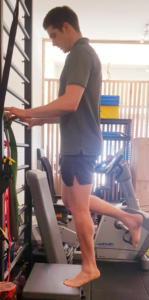
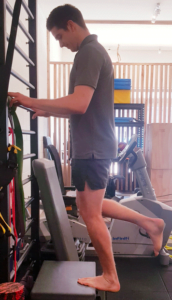
- Introduce speed, power, balance and acceleration:
Your calf is feeling strong and you’re ready to burst out the front door and run through the streets. Not so fast! Before you return to running it is vital you gradually build up your tolerance to explosive movements. When we run; our calf muscles and Achilles tendon absorb up to eight times our body weight with each stride. Following a strain or tear, our calf loses some of its elasticity and it can take a while for us to regain that spring in our step. Exercises such as skipping, single-leg hops and bounding may be prescribed by your health practitioner to improve your calf’s force absorption capabilities. These activities may also highlight any balance issues you might have and these will also need to be addressed before returning to sport.
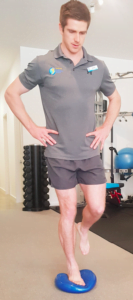
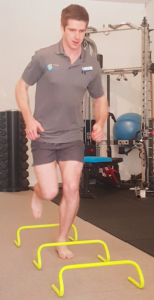
- Return to Sport:
Your calf is feeling strong, springy and ready to be tested outdoors. The first run back can be quite a mental hurdle and I’d recommend starting off with some short, easy strides to see how your calf responds. In my experience you will likely pull up tight and sore! Remember to complete a thorough warm up before each session and gradually build up the pace and distance of your runs. If you are feeling confident with straight-line running, gradually incorporate some change of direction (agility) work before easing your way back into training drills.
What I learnt: your calf may not be the problem!
During my rehabilitation I noticed that my left leg was considerably weaker than my right. My left glute muscles weren’t activating properly, and this caused a lot of instability through my pelvis. Muscular imbalances like mine are often the root cause of sporting injuries as they alter our biomechanics and reduce the efficiency of how our body moves. Booking in with your Osteo, Physio, Podiatrist or EP is a great starting point as they are experts at identifying weaknesses or asymmetries. They will give you a structured exercise program to strengthen these areas and stop that pesky injury from returning again. I wish I had done it sooner!
If you have any questions, please feel free to shoot me an email. We are always here to help!
James Breust
Osteopath
